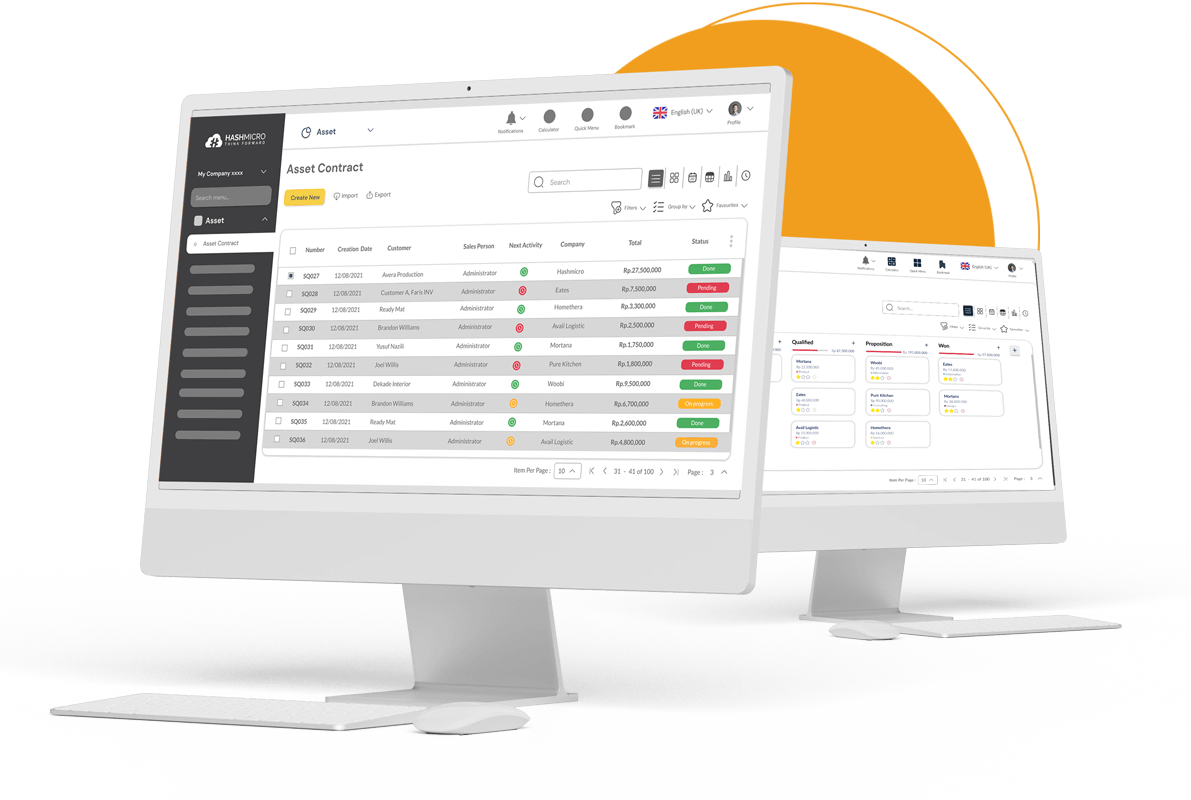Are you currently confused about how to manage the assets in the company? Or are you currently frustrated because the way you manage your assets is never right? If so, you are in the right place because this article will discuss asset management strategies.
An asset management strategy is a structured approach used to manage a company’s physical or non-physical assets to maximize their value. This strategy involves the process of planning to optimizing assets throughout their lifecycle to improve performance and manage risk effectively.
Gayunpaman, ang pag-alam sa kahulugan ng isang diskarte sa pamamahala ng asset ay hindi sapat para sa iyo, hindi ba? Therefore, continue reading this article as we will discuss asset management strategies in depth, starting from the types, benefits, and examples.
Table of Contents

Key Takeaways
|
What is Asset Management Strategy?
First, let’s start the discussion by knowing the definition of the asset management strategy itself. An asset management strategy is a systematic approach to optimally manage a company’s assets throughout their lifecycle.
These assets can be physical, such as buildings and machinery, or non-physical, such as copyrights or patents. This process involves planning, maintaining, and managing with the aim of maximizing asset value, improving performance, and extending asset life.
Because of its role in asset management, it is clear that the main role of an asset management strategy is to ensure that the company’s assets are used in the most efficient and effective way. This includes managing asset-related risks, optimizing maintenance costs, and keeping asset availability in optimal condition.
The implementation of an enterprise asset management strategy can indirectly bring significant benefits to the company. Some of these include reduced operational costs and better risk management.
In addition, this strategy also helps companies improve the efficiency of resource use, support sustainability, and ensure more informed decisions in terms of asset management.
Examples of Commonly Used Types of Asset Management Strategies
Basically, asset management strategies are divided into several types that are tailored to the needs and desires that can fulfill the company’s busy schedule. Therefore, it is important for you to know the types of asset management strategies below:
Preventive maintenance strategy
This strategy aims to maintain the condition of the asset through routine scheduled maintenance before the asset is damaged. With this approach, companies can prevent unplanned downtime and extend asset life. Preventive maintenance reduces the cost of sudden repairs that are often more expensive and helps keep the asset’s operational performance optimized.
Through regular inspections and periodic maintenance, companies can detect potential problems before they become bigger.
Predictive maintenance strategy
Unlike preventive maintenance, a predictive maintenance strategy utilizes real-time data from assets, such as vibration, temperature, or energy usage, to predict when assets need maintenance. With technologies such as IoT sensors and data analytics, companies can anticipate damage of asset performance before it occurs.
This strategy helps companies reduce downtime and optimize maintenance costs by only making repairs when absolutely necessary.
Asset replacement strategy
This strategy refers to the decision to replace an asset when the cost of maintenance or repair exceeds the benefits generated by the asset. Asset replacement can be based on age, performance, or current market conditions.
By conducting a thorough evaluation of the asset lifecycle, companies can determine when the time is right to replace assets to minimize costs and risks. This strategy helps ensure that the company is always using efficient and up-to-date technology and equipment.
Resource optimization strategy
This strategy emphasizes the effective utilization of assets to maximize productivity and operational efficiency. Proper asset allocation is crucial in optimizing resources, whether through strategic scheduling, efficient workforce distribution, or prudent inventory management to minimize waste. Organizations that implement this approach can reduce operational costs and enhance output without the need for substantial investments in new assets.
Asset risk management strategy
This strategy aims to identify, analyze, and manage risks related to company assets. Risk management can include physical (such as damage), financial (impairment), or legal compliance (not meeting regulatory standards) risks.
By implementing proper risk mitigation, companies can reduce the negative impact on operations due to asset issues. This strategy also ensures that critical assets get more attention in terms of maintenance and management.
Advantages of Implementing an Asset Management Strategy
Earlier, we said that implementing an asset management strategy can bring benefits such as reduced operational costs and better risk management. But are the benefits only limited to that? Of course not, here are the benefits of implementing an asset management strategy that you need to know:
Extending asset life
Asset management strategies, especially those involving routine and predictive maintenance, can extend asset life by keeping assets in top condition. By doing so, companies can delay costly asset replacements and maximize the value generated from those assets throughout their lifecycle. Longer-lasting assets mean long-term savings in capital investment.
Compliance with regulations and industry standards
Companies that implement an asset management strategy can ensure that their assets comply with applicable regulations and industry standards. For example, in highly regulated industries such as energy or manufacturing, maintaining this compliance is critical to avoid legal sanctions, penalties, or operational disruptions.
Improved operational performance
With effective asset management, companies can improve operational efficiency because assets are always in optimal condition. This allows companies to reduce downtime and maintain smooth operations. Equipment and machinery that work efficiently increase productivity, so that companies can meet production targets on time.
Better decision making based on data
Modern asset management implementations often involve the use of technologies such as sensors, analytics, and real-time data monitoring. So, what are the benefits derived from this? Yes, that’s right! With this data, management can make better decisions regarding resource allocation, maintenance planning, and asset replacement. Data-driven decisions reduce uncertainty and increase accuracy in strategic planning.
Modern and Traditional Asset Management Strategies, What’s the Difference?
That’s right, as technology advances, so do asset management strategies. However, what is the difference between modern and traditional management strategies? One of the main differences between traditional and modern asset management lies in the use of data and efficiency.
Furthermore, traditional asset management is usually reactive, where companies only take action when damage or problems occur on assets. Maintenance is carried out based on a routine schedule without considering the actual condition of the asset.
As a result, this approach tends to ignore detailed data collection and only focus on short-term fixes. As a result, sudden repair costs and downtime are often higher, because companies cannot anticipate damage before it occurs.
Modern asset management, on the other hand, uses advanced technologies such as the Internet of Things (IoT), sensors, and data analytics to monitor asset conditions in real-time. With this approach, companies can implement predictive maintenance, which allows them to foresee when assets will experience performance degradation or damage.
This enterprise digital asset management strategies is more proactive, so the impact is that companies can manage assets more efficiently and are able to reduce repair costs and downtime. The data collected also supports management to make better decisions regarding future policies.
5 Ways to Develop the Right Asset Management Strategy With Your Company
Sa puntong ito, nagsimula kang malaman ang mga diskarte sa pamamahala ng asset nang mas mahusay sa pamamagitan ng pag-unawa sa kanilang mga kahulugan, halimbawa, at benepisyo.However, you must also be curious about how to develop an asset management strategy that suits your business.
No need to worry, because we will provide 5 steps that you can take to implement the right asset management strategy through the explanation below:
Evaluate company needs and goals
The first step is to understand the company’s unique needs and set specific goals to be achieved with asset management. Companies should consider the type of assets they own, the asset lifecycle, and performance and efficiency targets. With clear objectives, such as reducing downtime or increasing asset life, companies can direct the appropriate asset management strategy to achieve optimal results.
Asset identification and classification
Developing an effective strategy requires an understanding of the assets owned by the company. Assets should be identified, classified based on their value, function, and priority. Critical assets that have a major impact on the company’s operations, for example, require more attention in terms of maintenance and management. With this classification, companies can focus on managing the most important assets first.
Utilize technology and supporting systems
Integrating technology, such as asset management system or IoT sensors, can help monitor assets in real-time and collect relevant data. This technology allows companies to implement predictive maintenance and identify potential problems before they occur.
The use of digital systems also makes it easier to report and analyze data, allowing management to make informed decisions. Meanwhile, one example of a system that you can use is HashMicro CMMS. This system is designed to manage company assets efficiently with seamless and easy integration capabilities.
So, by using HashMicro CMMS, you are not only facilitated to manage assets, but also one step easier to manage asset data with other department data in your business in one platform. If you are curious about HashMicro CMMS, you can schedule a free demo provided by clicking here!
If you are curious about other asset management systems, you can read our previous article on asset management software recommendations.
Plan for proactive maintenance
An effective asset management strategy should include a proactive maintenance plan. Instead of just waiting until an asset breaks down, companies can plan regular maintenance that is based on asset condition data. With scheduled and condition-based maintenance, companies can prevent unexpected downtime and extend asset life. It also helps optimize the use of maintenance resources.
Team training and development
Apart from technology, people are also a key element in an asset management strategy. The asset management team must have the right skills and knowledge to execute this strategy. Companies need to invest in training and development of the team’s capabilities, including the use of the latest technology and understanding of asset management best practices.
Achieve the Right Asset Management Strategy with HashMicro Asset System Implementation!

HashMicro’s asset performance management software makes it easy to manage critical assets such as machinery, vehicles, and heavy equipment. HashMicro also offers free demo and consultation services with a team of experts before making a purchase.
In addition, this software makes it easy to monitor the condition and location of assets, and accelerate the maintenance and repair process, which is often a key performance target (KPI) for asset management teams. Companies can easily find out detailed asset status, such as lost, damaged, mutation, renewal, repair, and asset destruction!
Here are the top features of asset management applications that can optimize the entire management of your company’s assets:
- Maintenance Scheduling: Users can create preventive and corrective maintenance schedules automatically, ensuring timely asset maintenance and reducing repair costs.
- Asset Maintenance Budget: Calculate total maintenance costs and asset revenues to determine BEP, ensuring expenses are within budget and maximizing cost efficiency.
- Asset Location Tracking: This asset management software feature uses GPS technology to track the condition and location of assets in real-time, and is integrated with a sophisticated IT inventory system, reducing the risk of lost or misplaced assets.
- Parent & Child Asset Management: This fixed asset management software feature facilitates the management of complex assets by organizing them in a hierarchical structure, where the main asset has sub-assets to provide a comprehensive overview of the relationship between assets.
- Fuel Log & Odometer Tracking: This feature in the asset program records fuel consumption and vehicle mileage to monitor fuel usage efficiency and vehicle performance.
- Repair Order Management: Efficiently manage repair orders, integrate with inventory systems, assist with repair request handling, repair status and history tracking, and asset cost management.
- Asset Stock Take with Barcode: Facilitate inventory checks using barcode asset tracking software, which can minimize errors, and improve accuracy in tracking the number and location of assets.
- Asset Comprehensive Cost Reporting: Generate detailed reports on asset values, including Return on Assets (RoA), asset value depreciation, and maintenance costs.
Conclusions
Asset management strategy is one of the effective ways used to manage the use of assets to be more optimal and efficient. By implementing this, companies can keep physical or non-physical assets at their best without disrupting production schedules.
Furthermore, using a digital system like HashMicro can help your management become more efficient with the comprehensive features offered. You can schedule a free demo to learn how the system works by clicking here!























